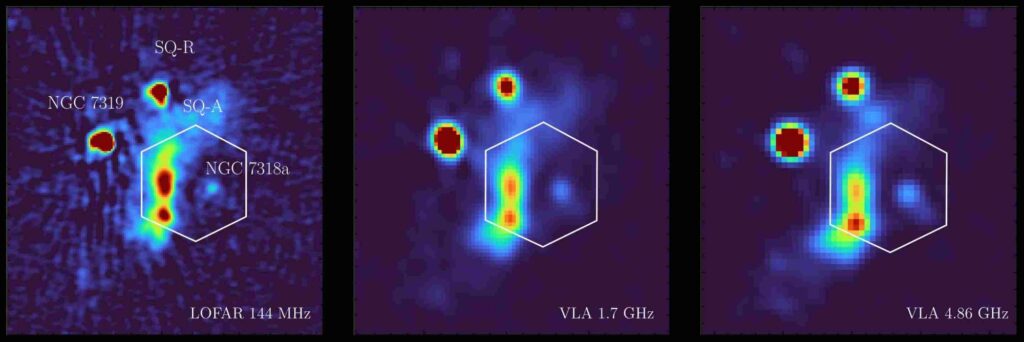A massive collision of galaxies sparked by one travelling at a scarcely-believable 2 million mph (3.2 million km/h) has been seen in unprecedented detail by one of Earth’s most powerful telescopes.
The dramatic impact was observed in Stephan’s Quintet, a nearby galaxy group made up of five galaxies first sighted almost 150 years ago.
It sparked an immensely powerful shock akin to a “sonic boom from a jet fighter” – the likes of which are among the most striking phenomena in the Universe.
Stephan’s Quintet represents “a galactic crossroad where past collisions between galaxies have left behind a complex field of debris”, which has now been reawakened by the passage of the galaxy, NGC 7318b.
The collision was spotted by a team of scientists using the first observations from the new 20-million Euro (£16.7million) William Herschel Telescope Enhanced Area Velocity Explorer (WEAVE) wide-field spectrograph in La Palma, Spain.
This cutting-edge, next generation science facility will not only reveal how our Milky Way galaxy was built up over billions of years, but also offer new insights into millions of other galaxies across the Universe.

The discovery of NGC 7318b smashing through Stephan’s Quintet was observed by a team of more than 60 astronomers and has been published today in Monthly Notices of the Royal Astronomical Society.
The system is an ideal laboratory to understand the chaotic and often violent relationship between galaxies, which is why it was the focus of the first-light observation by the WEAVE Large Integral Field Unit (LIFU).
Lead researcher Dr Marina Arnaudova, of the University of Hertfordshire, said: “Since its discovery in 1877, Stephan’s Quintet has captivated astronomers, because it represents a galactic crossroad where past collisions between galaxies have left behind a complex field of debris.
“Dynamical activity in this galaxy group has now been reawakened by a galaxy smashing through it at an incredible speed of over 2 million mph (3.2 million km/h), leading to an immensely powerful shock, much like a sonic boom from a jet fighter.”

The international team has uncovered a dual nature behind the shock front, previously unknown to astronomers.
“As the shock moves through pockets of cold gas, it travels at hypersonic speeds – several times the speed of sound in the intergalactic medium of Stephan’s Quintet* – powerful enough to rip apart electrons from atoms, leaving behind a glowing trail of charged gas, as seen with WEAVE,” Dr Arnaudova said.
However, when the shock passes through the surrounding hot gas, it becomes much weaker, according to PhD student Soumyadeep Das, of the University of Hertfordshire.
He added: “Instead of causing significant disruption, the weak shock compresses the hot gas, resulting in radio waves that are picked up by radio telescopes like the Low Frequency Array (LOFAR).”
The new insight and unprecedented detail came from WEAVE’s LIFU, combining data with other cutting-edge instruments such as the LOFAR, the Very Large Array (VLA), and the James Webb Space Telescope (JWST).
WEAVE is a state-of-the-art super-fast mapping device that has been connected to the William Herschel Telescope to analyse the composition of stars and gas both in the Milky Way and in distant galaxies.
This is done with the help of a spectroscope, which reveals the elements that stars are made of by generating a bar code-style pattern within a prism of colours that make up a source of light.
It was designed and built following a multi-lateral agreement by France, Italy and the countries of the Isaac Newton Group of Telescopes partnership (the UK, Spain and the Netherlands).
Astronomers hope that WEAVE will help reveal how our galaxy formed in unprecedented detail and revolutionise our understanding of the Universe.
Dr Daniel Smith, of the University of Hertfordshire, said: “It’s really neat work that Marina has put together with this large team, but this first WEAVE science paper also represents just a taste of what is to come over the next five years now that WEAVE is becoming fully operational.”
Professor Gavin Dalton, WEAVE principal investigator at RAL Space and the University of Oxford, said: “It’s fantastic to see the level of detail uncovered here by WEAVE.
“As well as the details of the shock and the unfolding collision that we see in Stephan’s Quintet, these observations provide a remarkable perspective on what may be happening in the formation and evolution of the barely resolved faint galaxies that we see at the limits of our current capabilities.”
Dr Marc Balcells, director of the Isaac Newton Group of Telescopes, said: “I’m excited to see that the data gathered at the WEAVE first light already provide a high-impact result, and I’m sure this is just an early example of the types of discoveries that will be made possible with WEAVE on the William Herschel Telescope in the coming years.”
Reference: M I Arnaudova et al, WEAVE First Light Observations: Origin and Dynamics of the Shock Front in Stephan’s Quintet, Monthly Notices of the Royal Astronomical Society (2024). DOI: 10.1093/mnras/stae2235
